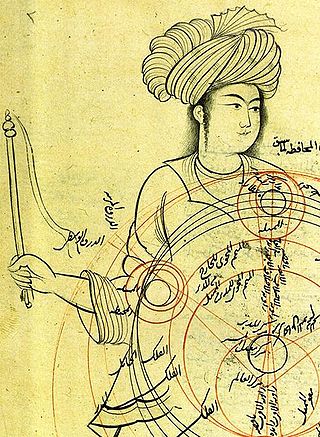Related Research Articles

Jalāl al-Dīn Muḥammad Rūmī, or simply Rumi, was a 13th-century poet, Hanafi faqih (jurist), Islamic scholar, Maturidi theologian (mutakallim), and Sufi mystic originally from Greater Khorasan in Greater Iran.

Sufism is a mystic body of religious practice found within Islam which is characterized by a focus on Islamic purification, spirituality, ritualism, and asceticism.

The Chishti order is a Sufi order of Sunni Islam named after the town of Chisht, Afghanistan where it was initiated by Abu Ishaq Shami. The order was brought to Herat and later spread across South Asia by Mu'in al-Din Chishti in the city of Ajmer.

Mu'in al-Din Hasan Chishti Sijzi, known reverentially as Khawaja Gharib Nawaz, was a Persian Islamic scholar and mystic from Sistan, who eventually ended up settling in the Indian subcontinent in the early 13th-century, where he promulgated the Chishtiyya order of Sunni mysticism. This particular Tariqa (order) became the dominant Islamic spiritual order in medieval India. Most of the Indian Sunni saints are Chishti in their affiliation, including Nizamuddin Awliya and Amir Khusrow.

Fakhr al-Din Iraqi was a Persian Sufi poet of the 13th-century. He is principally known for his mixed prose and poetry work, the Lama'at, as well as his divan, most of which were written in the form of a ghazal.

Taj Al-Din Ebrahim ibn Rushan Amir Al-Kurdi Al-Sanjani , titled Sheikh Zahed Gilani, was an Iranian Grandmaster of the famed Zahediyeh Sufi order at Lahijan. He is also known as Sultân-ûl Khalwatiyya and Tadj’ad-Dīn Ebraheem Zāheed al-Geylānī as well.

Safi-ad-Din Ardabili was a poet, mystic, teacher and Sufi master. He was the son-in-law and spiritual heir of the Sufi master Zahed Gilani, whose order—the Zahediyeh—he reformed and renamed the Safaviyya, which he led from 1301 to 1334.

Qotb al-Din Mahmoud b. Zia al-Din Mas'ud b. Mosleh Shirazi was a 13th-century Persian polymath and poet who made contributions to astronomy, mathematics, medicine, physics, music theory, philosophy and Sufism.

The Qadiriyya or the Qadiri order is a Sunni Sufi order (Tariqa) founded by Abdul Qadir Gilani, who was a Hanbali scholar from Gilan, Iran. The symbol of the order is the rose. A rose of green and white cloth, with a star in the middle, is traditionally worn in the cap of Qadiri dervishes. Robes of black felt are customarily worn as well. The names of God are prescribed as chants for repetition, or Dhikr, by initiates.

The Suhrawardi order is a Sufi order founded by Abu ’l-Nad̲j̲īb Suhrawardī. Lacking a centralised structure, it eventually divided into various branches. The order was especially prominent in India. The ideology of the Suhrawardi order was inspired by Junayd of Baghdad, a Persian scholar and mystic from Baghdad.

Abū al-Najīb Abd al-Qādir Suhrawardī (1097–1168) was a Sunni Persian Sufi who was born in Sohrevard, near Zanjan, and founded the Suhrawardiyya Sufi order. He studied Islamic law in Baghdad, later becoming professor of Shafi'ite law at the Nizamiyya school in the same city.

Baha-ud-din Zakariya, also known as Baha-ul-Haq, was a Punjabi Sunni Muslim scholar, saint and poet who established the Suhrawardiyya order of Baghdad in medieval South Asia, later becoming one of the most influential spiritual leaders of his era.

Shabaks are a group of people who live east of Mosul in Iraq. Their origin is uncertain and they are considered Kurds by some scholars. They speak Shabaki and live in a religious community (ta'ifa) in the Nineveh Plains. The ancestors of Shabaks were followers of the Safaviyya order, which was founded by the Kurdish mystic Safi-ad-din Ardabili in the early 14th century. The primary Shabak religious text is called the Buyruk or Kitab al-Manaqib, which is written in Turkmen.

Humam-i Tabrizi, was a Sufi poet of the Ilkhanate era, who composed works in Persian, as well as some in Arabic. He was one of the most distinguished figures of his time due to his poetry, teachings, piety, and Sufi spirituality.
The Buyruks are a collection of spiritual books providing the basis of the Alevi value system. Buyruk means “command” or “order” in Turkish. Topics addressed in the Buyruks include müsahiplik and a wide range of Alevi stories and poems, including the story of Haji Bektash Veli.

Khawaja Muhammad Qamar Ud Din Sialvi (1906–1981), was a Pakistani Islamic scholar, religious leader and politician. He was a Waliullah of the Chishti Sufi order; his Sufi convent (zawyah) is located in the village of Sial Sharif.

Akbari Sufism or Akbarism is a branch of Sufi metaphysics based on the teachings of Ibn Arabi, an Andalusian Sufi who was a gnostic and philosopher. The word is derived from Ibn Arabi's nickname, "Shaykh al-Akbar," meaning "the greatest master." 'Akbariyya' or 'Akbaris' have never been used to indicate a specific Sufi group or society. It is now used to refer to all historical or contemporary Sufi metaphysicians and Sufis influenced by Ibn Arabi's doctrine of Wahdat al-Wujud. It is not to be confused with Al Akbariyya, a secret Sufi society founded by Swedish Sufi 'Abdu l-Hadi Aguéli.

Badīʿ al-Dīn, known as Shāh Madār, and by the title Qutb-ul-Madar 1315–1434), was a Syrian Sufi who migrated to India where he founded the Madariyya Sufi brotherhood. He is held in high esteem as a patron saint.

The Maizbhandari, or sometimes Maijbhandari, order or tariqa of Sufism within Sunni Islam was founded in the late 19th century by the Bengali Sufi saint Ahmad Ullah Maizbhandari from Chittagong. It is the only Sufi order to have originated from within the Bengal region, and, as an indigenous movement, it has continued to enjoy significant popularity through to the 21st century.